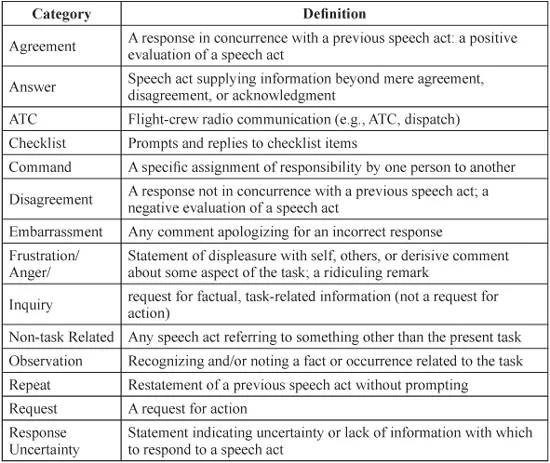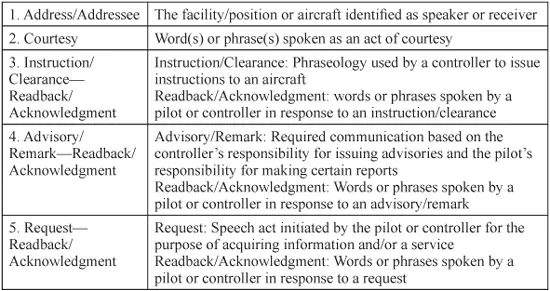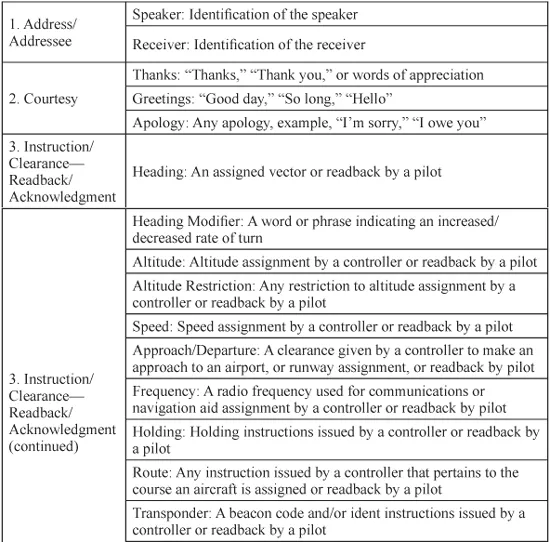![]()
PART I
The Effects of Linguistic Properties and Message Length on Misunderstandings in Aviation Communication
Immanuel Barshi
![]()
Chapter 1
Introduction to Part I
Aim and Scope of this Chapter
As explained in the Introduction to this book (p. 1), Part I is based on my Linguistics dissertation (Barshi 1997). I therefore begin this chapter by describing the problem that study addresses. I review the relevant research literature and the studies which provided the framework for the linguistic analysis offered here, and I outline the structure of the rest of Part I. I end this chapter with a brief presentation of the implications of this research to the practical domain of aviation communication.
Misunderstandings in Aviation Communication
Most aviation accidents and incidents are attributed to human error. In fact, in the chain of events leading to any accident, human errors often provide many of the links (Nagel 1988, O’Hare and Roscoe 1990). Of the various kinds of human errors found in aviation, problems in communication constitute a large majority. Billings and Reynard (1981) examined a sample of more than 12,000 ASRS (NASA’s Aviation Safety Reporting System) incident reports and found that over 73 percent of them contained evidence of a problem in the transfer of information. With communication being such a major problem in aviation, understanding communication errors is a crucial step towards improving flight safety. It is also a fascinating exploration of language processes.
Radio communication between aircrews and air traffic controllers is a highly organized discourse. The participants are well trained, the structure is clearly defined, and the domain is narrowly constrained. Nevertheless, misunderstandings occur with an alarming frequency. It is the purpose of my research to understand some of the factors influencing these misunderstandings so they can be prevented.
Prinzo and Britton (1993) offer a comprehensive review of studies concerning air traffic control (ATC)/pilot voice communication. In their conclusion, they recommend “apply[ing] a cognitive/psycholinguistic approach to identify problems in ATC message composition, delivery technique and memory limitations. Experimental research and high fidelity simulation studies need to be performed to address these issues” (p. 31). This study offers the kind of experimental research Prinzo and Britton recommend. In addition, it brings evidence from natural language analysis, together with evidence from experimental results, to converge on a single set of conclusions.
Striking a Balance
This is a good example of the general approach illustrated in our work, that of integrating the applied and the theoretical. We have both come to the research world of academia having had much practical experience in the field of aviation and thus a deep appreciation of the real problems and needs of the people involved. We were there ourselves. We experienced it first hand. Yet, we have also been curious about the deep nature of things, and that curiosity led us to our studies. Wanting to make a meaningful difference in the world, even if in small ways, has always been a strong motivation for us. At the same time, the academic environment has its own demands, and large research universities require graduate students to produce research work that contributes to theory. There is often little if any interest in so-called “applied work” at some research universities. Thus, a balance must be found such that the work done will meet university expectations and requirements, and at the same time contribute to practical situations in the real world. Striking such a balance isn’t trivial, but is well worth the effort. We hope this book and this line of work illustrate this balance.
Related Research
Prinzo and Britton (1993) were the first, and so far the only ones, to review the relevant research literature, and they categorize studies on pilot–controller radio communication along two dimensions: research approach and source of data. They list three research approaches: taxonomy, acoustics, and cognitive/psycholinguistic. They also list three sources of data: survey, field, and laboratory. This study focuses on the cognitive/psycholinguistic aspects and draws on the field and the laboratory as sources of data.
Many of the studies reviewed by Prinzo and Britton (1993) are descriptive in nature. Quoting from a draft of the final report of the Work Group on Human Factors Relating to Controller and Pilot Errors, they offer the following:
A review of relevant research work and operational analyses on errors in pilot–controller communication by the Work Group indicated that current analyses have focused primarily on the counting and description of pilot–controller communication errors, with little systematic work on developing explanations or examining the causes of errors. (Prinzo and Britton 1993: 4)1
One descriptive approach has focused on the structure of the language. Philps (1989, 1991) examined the syntactic structure of English used in French airspace in comparison with what he terms “Natural English” (British English). He discusses the “subgrammar” of the French speakers’ ATC English, arguing that “the syntactic regularities found in the phraseology differ in such a systematic way from those governing Natural English that they can be shown to constitute a subgrammar of English” (1991: 110). Philps then proceeds to show such systematic differences “using a transformational–generative framework.” He looks at sentence and phrase level transformations and modifications, particularly in terms of deletion and fronting. His main effort is to demonstrate how the constructions used in Aviation English can be derived via transformations and modifications from “Natural” English. Philps concludes that Aviation English is highly “elliptical” and that “the fundamental mechanism that allows the phraseology to function effectively as a communication tool is surely to be found in the interaction between its intra-and extra-linguistic levels. The phraseology in fact interweaves two systems: the structural system of an English subgrammar and a system of referential values common to its domain (ATC) and to the speech community within its domain” (p. 123). I shall return to a more detailed discussion of Philps’ work in Chapter 3.
Another descriptive approach has focused on the communicative interaction. In a series of studies, Linde and her collaborators (Goguen and Linde 1983, Goguen, Linde, and Murphy 1985, Linde 1988a, 1988b, 1988c, Linde, Goguen, and Devenish 1986, Linde, Goguen, Finnie, MacKaye, and Wescoat 1987) have looked at various pragmatic aspects of aircrew communication. Their focus has been on social mitigation in communication between crew members, and particularly as reflecting social status and rank. Unlike Philps’ (1991) analysis, which is framed within transformational grammar and is primarily syntactic, Linde’s work is framed within speech act theory (Searle 1969) and has focused on the social interaction. Following the seminal work by Goguen and Linde (1983), in which they developed a speech act taxonomy for cockpit communication, Kanki and Foushee (1989) further developed a speech act coding scheme to analyze flight crew communication. This coding scheme is outlined in Table 1.1.
Several other investigators have expanded this coding framework to communication between the crew and the controllers on the ground, and have based their quantitative analyses of recorded ATC communication data on the notion of speech acts. Such speech acts do indeed provide for a convenient classification scheme. Morrow and his collaborators (Clark, Morrow, and Rodvold 1990, Morrow, Clark, Lee, and Rodvold 1990; Morrow, Lee, and Rodvold 1990, 1991, 1993, Morrow and Rodvold 1993, 1998, Morrow, Rodvold, and Lee 1994) have viewed the interactions between pilots and controllers within an information-processing framework (e.g., McCoy and Funk 1991), and as a collaborative effort (e.g., Clark and Schaefer 1987). Within these frameworks, they have focused primarily on the speech acts of commands and requests. Cardosi (1993a, 1993b, 1994), Cardosi, Brett, and Han (1996), Prinzo and Britton (1994), and Bürki-Cohen (1995a, 1995b, 1996) have all used the notion of a speech act as the basic underlying unit of analysis in ways similar to those suggested in Goguen and Linde (1983) and in Kanki and Foushee (1989). Most recently, Prinzo, Britton, and Hendrix (1996) have developed a coding scheme especially suited for the analysis of ATC communication between approach control2 and pilots. This coding scheme combines the notions of speech acts and topics into a single framework.
Table 1.1 Summary of the Kanki and Foushee (1989) Speech Act Coding Scheme 3
A later taxonomy, the Aviation Topic/Speech Act Taxonomy (ATSAT) of Prinzo et al. (1996) divides messages into speech acts much like Kanki and Foushee (1989) did, and further identifies aviation topics within the speech act categories. The ATSAT researchers arrived at their taxonomy by taking the speech act categories developed by Kanki and Foushee (1989), restricting them to communication between the crew and the controllers on the ground (i.e., excluding communication between flight crew members), and testing the various categories against data of recorded ATC communication. “Based on the VHF/UHF audiotapes provided, some of the speech acts were combined into a single category and several aviation topics were discarded or replaced” (Prinzo, Britton, and Hendrix 1996: A–54). The resulting taxonomy is shown in Table 1.2, which lists the speech act categories and their definitions; and Table 1.3, which lists the aviation topics within the speech act categories. The aviation topics of the ATSAT framework will be used extensively throughout this book as the basic unit of message length. That is, ATC messages will be counted in terms of the number of aviation topics they contain.
Table 1.2 Definition of Aviation Topic/Speech Act Taxonomy (ATSAT) Speech Act Categories4
Table 1.3 Aviation Topics within ATSAT’s Speech Act Categories5
In studies that have used the speech act as the unit of analysis, message length has often been defined as the number of speech acts. However, much of a controller’s message could be considered a single speech act if it consists of all requests, or all commands, even though each refers to a different aviation topic. That is, a message that includes instructions to change heading, altitude and speed could be considered a single speech act of “command,” though it contains three distinct aviation topics.
To clarify this potential difference in definitions, when it comes to elements involved in misunderstandings, researchers have taken different routes. Cardosi (e.g., 1994) refers to “pieces of information” in calculating “message complexity.” However, Cardosi et al. (1996), state that “only the pieces of information that increase memory load were counted as separate elements” (p. 3). They specify that “the aircraft call sign was not counted as an element, since it serves only to attract the pilot’s attention and is not something that must be remembered as a part of the message” (p. 3). The many errors in call signs that they (among others) report raise questions about this decision to exclude the call sign from the count. Furthermore, it is not clear how “memory load” is determined and how “increase in memory load” is measured. In general, Cardosi and her collaborators (1993a, 1994, Bürki-Cohen 1995b, Cardosi et al. 1996) have been counting as separate elements “things that pilots can make an error on” (personal communication, November, 1996). However, a radio frequency, for example, includes up to five different digits (e.g., one three two point seven five) and represents opportunities for errors on any one of four digits/slots (the first digit is always one). Yet, Cardosi counts an instruction to change a radio frequency as a single element, not as four different elements.
Morrow and his collaborators (e.g., Morrow and Rodvold 1998) have been counting message length in terms of speech acts, but in a manner very similar to the notion of aviation topics. Thus, a controller’s message that includes instructions about heading, altitude, and speed is considered to be made of three different speech acts, all “commands.” However, Morrow and his collaborators do not articulate clearly a definition or a criterion for their choice of a length unit.
One investigator who has been focusing on some sources of errors in ATC communication is Steven Cushing.6 In a number of studies, Cushing (1987, 1994a, 1994b, 1994c) has focused on classifying communication problems into such linguistic and behavioral classes as homophony of words, referential ambiguities, punctuation and intonation, Readbacks, wrong inferences, and false assumptions. In focusing on single words or phrases, Cushing has parted from the focus on speech acts and interaction seen in the other studies described above. The sources of errors Cushing points out are, in a sense, generic communication errors that are not unique to ATC communication or to Aviation English and are part of the “risk” people take when they engage in any type of communicative interaction. In fact, many of the examples Cushing uses are taken from everyday face-to-face communication and not from aviation discourse. Furthermore, most of his aviation communication examples are taken from...




